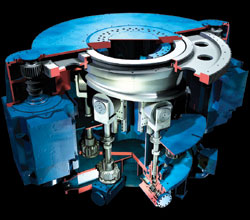Drilling developments
West Texas test well. On December 28, 2001, Texas Tech University’s Department of Petroleum Engineering completed the Red Raider No. 1 test well, drilled to 4,120 ft and completed with 9-5/8-in., 43.5 lb/ft, N-80 casing. The well is operated under the Center of Advanced Production Research Operations (CAPRO). Its purpose is to provide a location for training undergraduate students in oilfield operations. In addition, it will be used as a full-scale research facility for installation, testing and development of oil/gas production technologies. And it will provide the industry with a central location to evaluate artificial lift technologies. The facility is located on 8.7 acres of University property in Lubbock, Texas. This summer, the Department of Petroleum Engineering will continue its expansion of the facilities by installing surface production equipment, to include crude and water storage tanks, gas pipeline connection, pump stations, metering and measurement packages, and separation / treating units. When completed, the facility will be capable of testing all forms of artificial lift installations at rates as high as 20,000 bpd and 3 MMcfd gas. Future development will include a series of horizontal flow loops for studying multiphase flow. The test well was drilled and constructed by donations from industry of equipment and services. Industry contributors include: Patterson-UTI Energy; Allen’s Casing Crews; Butch’s Rat Hole & Anchor Service; Halliburton Energy Services; Bestolife Corp.; Diamond Oil Well Drilling Co.; Robert McHam, Inc.; Schlumberger Wireline Services; Cameron; Lone Star Steel; Permian Bit Service; and Baroid. For information, contact: Ms. Anita Parks, Tel: 806 742 1801, ext. 244; Fax: 806 742 3502. New mud pump. One of the more interesting pieces of drilling equipment at the recent OTC exhibit was the Hex Pump 150 on National Oilwell’s stand. The prototype displayed will be further tested in the UK.
The Hex Pump utilizes six piston / plungers arranged vertically in a cylinder-shaped pump assembly. A specially-profiled cam rotates above these six piston / plungers to produce the pumping action, with specific timing to significantly minimize output pulsations, compared to those normally characteristic of traditional pumps. One picture is worth a thousand words in this case, see photo. Driven by two AC motors, the cam operation also produces a more constant piston / plunger speed and flowrate, extending the life of valves and mechanical components. With the flexibility of AC drive, the pump can perform either high-pressure or high-flow operations without changing liner size. And the round design and compact footprint maximizes its ability to be installed in a variety of environments where space is limited. The pump uses two 738-hp AC motors; max pump speed is 212 spm, delivering 827 gpm at 7,500 psi. Major benefits claimed include: up to 45% smaller footprint and 35% less weight; less vibration / noise; more consistent plunger speed; and minimized output pulsation. National has not said when the new system would be operational. Continuous circulation drilling. Development of rig floor equipment that will allow the continuous circulation of drilling mud while making a drill pipe connection is nearing completion. The principal tool, using the configuration of a triple ram BOP, is called the "Coupler." The system, which is used on rigs with Top Drives, is the "Continuous Circulation System (CCS)." The CCS is undergoing trials in May / June this year, prior to expected commercial availability in 4th quarter 2002. The Coupler allows making connections at full circulating pressure with drill fluid flowing through the drillstring after the box and pin have been separated. The Coupler seals around the drillstring with pipe rams above and below the uppermost connection – i.e., the connection between the drill pipe and the Top Drive wear sub. After backing off, the wear sub is raised and isolated from the drillstring by blind rams. After bleeding off the pressure, the wear sub is released from the Coupler to pick up the next stand / single of drill pipe. This is inserted into the Coupler, the upper pipe rams close and are pressured up with mud. The blind rams can then be opened and the new stand lowered and made up to the string. At no time does flow to the drillstring cease and, at all times, pressure and flow are under continuous control. The Coupler is designed to sit on the rig floor and skid over the rotary table, as does an iron roughneck. The prototype is 9-1/8-in. bore with a working pressure rating of 5,000 psi. Alternative versions may be justified for handling casing and smaller-OD drill pipe. Higher working pressure ratings are also under consideration. The developers say the system can be retro-fitted with relative ease to over a thousand existing rigs that use a Top Drive, and up to a thousand more may justify upgrading to a Top Drive to use a CCS. There are many operational advantages to maintaining circulation, including downhole pressure maintenance, hole cleaning, maintaining a "steady state," and safety. The system and its advantages are reviewed in Paper OTC 14269. CCS is the subject of an Industry Facilitator (IF) JIP. Current participants are six operators, plus Coupler Developments Ltd., Maris Intn’l. and Varco Drilling Equipment. Contact: Laurie Ayling or Jim Jenner, Maris International Ltd., Bagshot, Surrey, UK; Tel: 44 1276 489489; Fax: 1276 489481; or Hugh Elkins, Varco Drilling Equipment, Houston; Tel: 713 937 5588; Fax: 713 937 5614. |
- Coiled tubing drilling’s role in the energy transition (March 2024)
- Using data to create new completion efficiencies (February 2024)
- Digital tool kit enhances real-time decision-making to improve drilling efficiency and performance (February 2024)
- E&P outside the U.S. maintains a disciplined pace (February 2024)
- Prices and governmental policies combine to stymie Canadian upstream growth (February 2024)
- U.S. operators reduce activity as crude prices plunge (February 2024)




